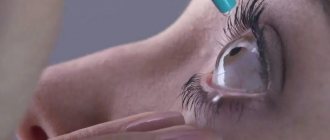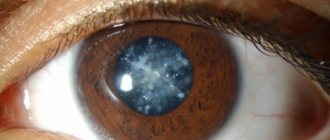Anti-inflammatory eye drops are a common remedy in the treatment of ophthalmic diseases. During therapy, drugs of various groups can be used. The effectiveness of treatment depends on the correct choice of medication.
Indications for use
Infection occurs when microbes appear in the eye area. Bacterial infection causes the appearance of stye, keratitis, conjunctivitis and other inflammatory diseases. Antibacterial drops are used to neutralize them.
Symptoms for which this medicine is prescribed:
- Pain in the area of the visual organ, constant desire to scratch the visual organ.
- Redness and swelling, not caused by anything. If a person sits at the computer all evening, and the next day his eyes acquire a reddish tint, then there is no need to sow panic. But if redness or swelling occurs for no apparent reason, there is an infection that needs to be treated immediately.
- A sharp decrease in vision.
- Eyes constantly water and react negatively to light. It is difficult to be in a bright room; the visual organ hurts and bothers the person. The release of tears when there is a sudden change in light. For example, when leaving a dark room into a light one;
- Purulent discharge.
If the above symptoms occur, you should immediately consult a doctor for treatment.
Antibacterial drops are also prescribed to prevent infections. Most often, in this case, they are prescribed to people predisposed to inflammatory processes. An example is a patient who constantly has problems with the visual organ, which is very sensitive to external influences. Weak in its structure.
Why do my eyes get inflamed?
The area of localization of such a pathological process is, or rather, the lower eyelid, cornea, mucous membrane or conjunctiva. In each specific case, inflammation is provoked by certain factors. Damage to the eyeball can be caused by the following reasons:
- trigeminal neuritis;
- mechanical trauma or burn of the cornea;
- proliferation of the vascular network;
- prolonged stress caused by work requiring increased attention and precision;
- ulcerative lesions of the cornea;
- contact with the eyeballs of pathogenic microorganisms.
The causes of inflammation of the lower and upper eyelids are:
- prolonged crying;
- heavy load on the organs of vision;
- poor immunity;
- blepharitis;
- inflammation of the eyelids caused by pathogenic bacteria or even mites;
- hormonal imbalance;
- allergy.
In general, the causes of eye inflammation can be very diverse. Some pathologies in which this problem occurs:
- Impetigo
is a bacterial infection of nearby skin. - Canaliculitis
is a pathological condition in which the lacrimal sac becomes inflamed with subsequent spread of the process to the conjunctiva. It can be caused by pathogenic bacteria, fungi or viruses. - Exophthalmos
is a disorder in which protrusion of the eyeballs is observed. At an advanced stage of the disease, the conjunctiva becomes swollen and inflamed. - Molluscum contagiosum
is a viral infection of the skin of the eyelids. Over time, the area of influence of the infectious agent spreads: it reaches the conjunctiva.
Inflammation of the anterior choroid and iris can develop with the following diseases:
- syphilis;
- advanced caries;
- brucellosis;
- leptospirosis;
- tuberculosis;
- rheumatism;
- gout;
- flu
In addition, the eyes can become inflamed from the wind. The organs of vision are not protected by the skin, so external circumstances have a strong impact on their condition. The risk of developing an inflammatory process is increased by the following factors:
- long stay near the air conditioner;
- drafts;
- traveling in a vehicle near an open window;
- Walking in cold weather after taking a shower or bath.
Classification of antibacterial drops
Classifies according to its effect on bacteria.
There are three types:
- They act destructively on the cell wall. The cell wall allows the bacteria to obtain nutrients. It determines the characteristics of the microorganism. If it is violated, the virus quickly dies.
- They affect the structure itself. When exposed to the structure, the bacterium is destroyed from the inside in a fairly short period of time.
- Slow down or completely stop the generation of nucleic acids. The production of new bacteria stops due to a disruption in the composition of the cell.
When choosing a type, you need to be guided by their contraindications. Each species has its own. It is better to consult an ophthalmologist for an appointment. If you make the wrong choice, there is a possibility of pathologies arising.
List for adults
Adult drops have different properties from children's formulations. Below we consider a list of the most popular drugs for adults.
Albucid
Antibacterial drops. They stop the reproduction of bacteria and disrupt its composition. After this, the cell stops its active life and gradually dies.
Albucid is prescribed two drops up to six times a day. When instilled, people feel a burning sensation, pain, and tears may flow. Cost – 20-50 rubles.
Oftadek
Used against microbes, fungus. It is not addictive, so it can be prescribed for a long period. It is considered one of the most effective antimicrobial agents. The cost of Oftadek is 50-70 rubles.
Levomycetin
Inexpensive but effective remedy. It is popular due to its low cost. Used for inflammation and infections. The cost of Levomycetin is 10-20 rubles.
Normax
Does not completely kill the microbe, but stops reproduction. After some time, the infection goes away on its own from the body. Instill Normax no more than five times a day. Costs from 120 rubles.
Azidrop
An effective remedy against a huge list of diseases. It is a universal medicine with a wide spectrum. Azidrop is also prescribed for the prevention of diseases. Instill once over several days. It has a number of contraindications and side effects. Use carefully to avoid problems. Cost – 300 rubles.
Sofradex
Contains an antibiotic. It is used not only for infections, but also for inflammatory processes. Indications: redness, allergies, irritation. It is not recommended to use for more than one week. Do not combine with other drugs. The cost of Sofradex is 320-340 rubles.
Tobropt
Antibacterial drops, which are prescribed for treatment and prevention of diseases after surgery. They are instilled depending on the severity of the disease. The cost of Tobropt is 100 rubles.
Vitabact
Used for many diseases. The duration of the course is no more than 10 days, since the drug can be addictive. The cost of Vitabact is 200 rubles. The choice must be taken seriously. Carefully study contraindications, action and application.
Carefully monitor your well-being after use. If side effects occur, stop use. Contact an ophthalmologist immediately. It is better to use drugs with a wide range of indications, so the risk of using the wrong drug is reduced.
List for children
Children can be prescribed the same drugs as adults, but with a reduced dosage. There are a number of drugs that are aimed specifically at the children's body.
Fucithalmic
Used for inflammatory processes. The peculiarity is that the medicine does not contain contraindications. Contains substances that do not cause allergic reactions.
Available for use by babies from birth. Premature newborns should not use these drops. The cost of Futsitalmic is 250-300 rubles.
Phloxal
It is prescribed both for infectious and inflammatory processes, and for the prevention of diseases. Not addictive. Instill two drops of Floxal no more than four times a day. From 150 rubles.
Maxitrol
A hormonal bactericidal agent that contains an antibiotic. The effect is felt after just a few uses. The cost of Maxitrol is 300 rubles.
Sodium sulfate
You can put the solution in the eyes of babies from birth. Use only 10% sodium sulfate. Safe and effective.
Consult your ophthalmologist for use in children. Without the appointment of a specialist, children are prohibited from using all types of drips, as this can have a detrimental effect on the baby’s body.
We recommend reading: How to put drops in a child’s eyes
Anti-inflammatory drops with antibacterial effect
Drugs are prescribed for infections aimed at the visual organ. Anti-inflammatory drugs are also used for viruses in which the eye is not the main target of infection (measles, rubella, chickenpox).
This type is aimed at producing a special substance that improves immunity and forces the body to fight the inflammatory process.
If antibacterial drops are aimed at destroying bacteria, then anti-inflammatory drops increase immunity and encourage the body to fight foreign antibodies.
Aktipol
It is used only if there are antibodies in the body that reduce immunity. A good antivirus product. Can be prescribed to people working with radiation. Protects against radiation. It is possible to combine with other drugs. The cost of Aktipol is from 100 rubles. The exact price depends on the region in which the medicine is purchased and the pharmacy chain.
Oftan I'm coming
Used for keratitis, keratoconjunctivitis, herpes. It has a number of contraindications. In particular, it should not be used by pregnant women. The course of treatment is up to 2 weeks. The cost of Oftan Idu is 150-200 rubles.
Oftalmoferon
Broad spectrum product. Acts as an antiviral, analgesic and anti-allergenic drug. Its effect is felt within a few minutes after instillation. It contains a large list of side effects, so you need to take the product strictly with the indicated dosage. The cost of Oftalmoferon is 300-500 rubles.
How is eye inflammation treated?
The choice of therapy depends on the area of the lesion and the cause that provoked this pathological process. An ophthalmologist should prescribe how to treat eye inflammation. Before prescribing drug treatment, he will refer the patient for a diagnostic examination. If a boil, abscess or phlegmon is detected on the eyelid, antibacterial drugs must be prescribed. The following tablets are most often prescribed:
- Oxacillin;
- Ampicillin;
- Bactrim;
- Biseptol.
For acute blepharitis, antibacterial ointments are used. These medications are often used:
- Erythromycin;
- Bacitracin;
- Gentamicin;
- Polymyxin B.
For conjunctivitis, antiseptic, antiallergic, antiviral, antibacterial or hormonal drugs can be prescribed. For a viral type of disease, the following medications are prescribed:
- Bonafton;
- Acyclovir;
- Florenal;
- Zovirax.
If the pathological condition is provoked by pathogenic bacteria, the following antibacterial ointments are used to combat it:
- Tobrex;
- Eubetal;
- Colbiocin;
- Phloxal;
- Erythromycin.
As for antiseptics, the following drugs are most often prescribed:
- Ethacridine;
- Miramistin;
- Picloxidine.
For conjunctivitis, the following hormonal drugs are used:
- Hydrocortisone;
- Prednisolone.
Rules for using drops
It must be remembered that the effectiveness of use depends not only on the chosen product, but also on the correctness of its application. Recommendations for treatment can be obtained during a consultation with an ophthalmologist.
There are several rules that, if followed, will not cause harm:
- Before instillation, you must wash your hands thoroughly with soap to avoid infection. Do not touch your eyes with dirty hands. If they seem clean, you still need to wash them with the product.
- After opening the bottle, check for damage to the pipette. If the pipette is damaged, then it is better not to use such a product or use it with extreme caution. Increases the likelihood of mechanical damage.
- You need to choose a comfortable position for your fingers. Usually the bottle is held with the thumb and forefinger. This makes it easier to squeeze out the medicine.
- Under no circumstances should the pipette touch the mucous membrane, as this will introduce infection into the bottle itself. There is no benefit to such instillation.
- Take a comfortable position: lie on the bed or simply throw your head back. When instilling, you need to look up.
- Push back the lower eyelid with your fingertips. You need to act carefully so as not to damage the visual organ.
- Bring the bottle closer to the eye and drop the required amount.
- Close your eyes and lie there for a couple of minutes. For even distribution, lightly press the inner corners.
- Repeat the procedure for the second eye.
If the instructions are followed correctly, the treatment will become effective, and the organ itself will not suffer any damage.
How to use eye drops?
It is important to perform this procedure correctly, otherwise the situation may worsen. All eye drops for inflammation come with accompanying instructions: they must be carefully studied before using the drug. The instillation itself is carried out as follows:
- You need to wash your hands thoroughly.
- If the patient wears lenses, they should be removed. It will be possible to insert it back only 10-15 minutes after the procedure.
- If eye drops for allergies and inflammation were stored in the refrigerator, the bottle with them is slightly warmed in the palms of your hands.
- Throw back the head and pull back the lower eyelid. The bottle containing antibacterial and anti-inflammatory eye drops is turned upside down and a drop of the drug is squeezed into the space between the eyeball and the eyelid. The container should not come into contact with either the eye or the skin.
- They close their eyes. Then gently, without making excessive efforts, massage the lower eyelid.
Reviews
Oleg: My eyes became inflamed and swollen, they burned and tormented me with pain. It's not a pleasant sight. I went to the doctor. I was prescribed Oftalmoferon. Dosage – 3 times a day. The very next day the swelling subsided and I began to feel much better. There were unpleasant sensations when instilling them. It burns and burns. But everything goes away in about 20 seconds. Pros: quick action, efficiency. Of the minuses, I would note the high cost.
Ekaterina: The baby was a month old when we were affected by eye problems. I immediately consulted a doctor. The doctor prescribed Fucithalmic. Although the dosage was prescribed, I still read the instructions. The medicine turned out to have no contraindications and a natural composition. It worked quickly and painlessly.
Nelly: After the operation, antibacterial drops were prescribed - Tobropt. I was pleased with the low cost (per package – 85 rubles). The drops are not felt at all on the eye. No pain, burning or irritation. The postoperative period was painless for me thanks to this drug.
conclusions
Antibacterial drugs are often used in ophthalmology. They are effective and safe when taken in the correct dosage and following safety precautions. It is recommended not to self-medicate. If problems arise, immediately contact an ophthalmologist. He will prescribe the drug, dosage and course of treatment.
Author's rating
Author of the article
Alexandrova O.M.
Articles written
2031
about the author
Was the article helpful?
Rate the material on a five-point scale!
( 4 ratings, average: 5.00 out of 5)
If you have any questions or want to share your opinion or experience, write a comment below.
How to choose eye drops?
Pharmaceutical companies produce a huge variety of similar drugs. Some solutions are oil-based, while others are water-based. All appointments must be made by an ophthalmologist. He not only knows what types of eye drops exist, but will also be able to select the most effective treatment regimen. It is impossible to use drugs uncontrollably: this will only aggravate the situation.











